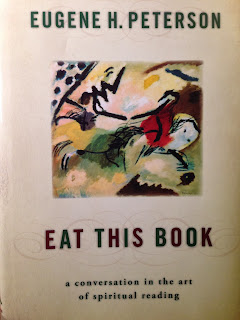Eat this Book
Review of Eugene H. Peterson, Eat this Book: A Conversation in the art of Spiritual Reading
(Eerdmans, 2006).
Best known as the translator of the Bible into The Message translation, Eugene Peterson
is a pastor and spiritual guide. This is
a simply marvellous book that introduces what it means for Christians to read
the Bible. It is broad in its outlook,
focussed in its application and generous in its spirit. I thoroughly recommend it.
Peterson begins from the observation that “in order to read
the Scriptures adequately and accurately, it is necessary at the same time to
live them” (p. xii). Thus he takes his
theme from Revelation 10.9-10, when the Seer is given a scroll to eat. Peterson, with an imaginative move that
characterises his approach, links this to Isaiah’s vision of a lion growling
over his prey (Isaiah 31.4). He notes
that the Hebrew verb translated as ‘growls’ in Isaiah is more usually
translated as ‘meditates’ (e.g. in Psalms 1.2; 63.6). This visceral, edible approach to the
Scriptures is Peterson’s emphasis. The
Scriptures are to be eaten, and eaten with relish, growling as they go down!
Scripture is a revelation and it is personal. It is the Triune God that makes this
revelation personal in every respect.
Peterson rightly rejects a highbrow approach to Christian doctrine, and
sees the doctrine of the Trinity as the work of ordinary Christians learning to
read their Bibles. He warns of the the
danger of using the Bible for our own purposes, and of the ‘replacement
trinity’ of our own needs, wants and feelings that endanger our reading of the
Bible.
Above all, the Bible is a story, “an immense, sprawling,
capacious narrative” (p. 40) that we can find ourselves inside. Story is the form of the Bible and the form
of God’s interaction with us. Stories
must be honest, not sentimental, propagandist or trivialising. Ultimately the story of the Bible invites us
into the story that is the life of God.
Christian living is then a response to the invitation of the Biblical
story. It is to cultivate habits of
reading that allow the Biblical story to take charge of us. This involves hard
things which are difficult to stomach.
“Eat this book, but also have a well-stocked cupboard of Alka-Seltzer
and Pepto-Bismol at hand” (p. 66).
Peterson commends the liturgical reading of Scripture, reading within
the community. Such reading takes us
first of all in to the place of adoration and then sends us out into the world
to live to the glory of God. Amen, let
it be so.
The final part of the book, appropriately for the translator
of The Message, looks at translating
the Bible. Peterson holds both that the
Bible is intelligible in translation, and that all translation involves
interpretation, even mistranslation.
Perhaps that is inevitable, given that (as Peterson reminds us) the
first Biblical translator was Pontius Pilate, identifying Jesus in three
languages. It is also worth noting that
Peterson (rightly in my view) is critical of the Authorised Version, preferring
William Tyndale’s translation that aimed to reach the ordinary folk of his
day. “The King James translators put out
a version of the Bible that became the literary classic of the Western World,
but at the expense of Tyndale’s plowboy” (p. 163).
The heart of this book, however, is not Peterson’s
understanding of the Bible, nor his insights into translation. It is his teaching on the ancient practice of
Lectio Divina. This, for Peterson, is a form of living the
Scriptures through the four movements of reading, mediating, praying and contemplating. Here prayer and Bible reading are seamlessly
linked. It involves wrestling with
difficulties and being honest as we come before God (“the Psalms are an
extended refutation that prayer is ‘being nice’ before God” (p. 105)). But above all it is living the text of the
Bible that Lectio Divina enables.
Although this is the second book in a five volume series, it
stands very well on its own. It is well
written, with good insight. There are
some nice asides, such as the dangers of using the Bible as a Rorschach test,
and reading commentaries as “analogous to the gathering of football fans in the
local bar after the game, replaying in endless detail the game they have just
watched” (p. 54). But above all it is
deep, full of integrity and enabling of life.
I highly commend it



Comments